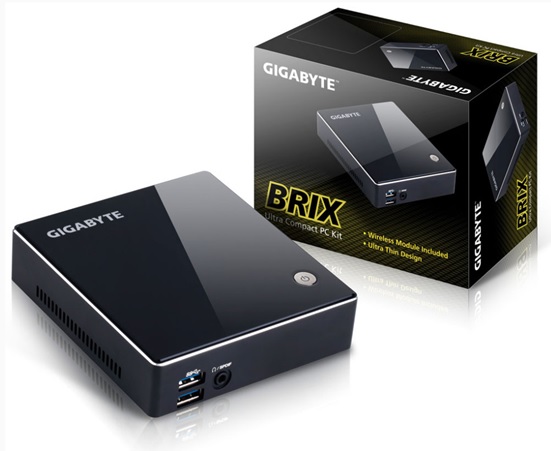Even Dave James’ fat hands are nimble enough to build a
mini-pc, so why not let a little machine into your living room.
For all Valve’s posturing about bringing the PC into the
living room, the small form factor PC isn’t a new thing. But whether we’re
talking about Intel’s NUC, Gigabyte’s BRIX or the various ickle boxes from
Zotac or Sapphire, they’ve always had one thing in common: they leave us
wanting more. When you’re a stand-up comic, an after dinner speaker or an acid
jazz mime-artist, that’s a fine thing to aim for, but we want a little machine
to offer everything from the outset.

The BRIX
from GIGABYTE redefines the desktop PC in terms of miniaturization
with a sleek chassis design that sits snugly in the palm of a hand.
The common problem is that modern computing is tending ever
more towards visual rather than straight computational performance. Graphics
componentry takes up a great deal of power and silicon space, while generating
more operational heat than a potassium swimsuit, which means you either have a
small box with practically zero graphical performance, or a chunkier, louder
box with more of a nod towards visual computing.
Distilling that further means a compromise between either
integrated or discrete graphics. Historically, integrated graphics have been
nothing to write home about, but that’s changing. Intel pushed things further
by sticking some extra DDR2 silicon into its top-end Haswell parts to create
the Iris Pro, and now AMD has released its GCN-powered Kaveri APUs with their
beefed-up graphics cores.

The Kaveri
APUs enhance the IPC upto 20% over Piledriver while GCN cores deliver
increased graphics performance compared to the older VLIW based integrated
graphics
Both of these integrated options eliminate the demand for
discrete graphics silicon to produce decent graphical performance, and that
means you can create tiny little machines that will allow you to game at
reasonable settings on your telly. If you’re rocking a badass desktop rig in
your man cave then such a small form factor PC will be more than happy
streaming your entire Steam library over your home network at the highest
settings too. And if we’re talking about streaming, then do we even need such
high-powered PC parts in our mini machine at all? Let’s find out…
Choices,
choices
Your options for making the perfect mini machine:
CPU Intel
Core i5-4670K ($296), AMD A10-7850K ($208)
The Core i5 is our favourite chip for a gaming rig, even
when our PC is a small form factor one. Pair it up with a discrete GPU, tap
into the overclocking potential of Haswell and watch your system fly. If you’re
not looking to overclock, then the cheaper i5-4570 is also an excellent option.

The Intel
Core i5-3570K is a Quad Core processors that features
22nm 3-D Tri-Gate transistors delivering a great combination of performance
However, AMD’s latest APU is the king of integrated
graphics. The GCN-powered chip is capable of some decent gaming performance
without a discrete graphics card to prop it up. A little tweaking can further
help its performance; for example, boosting the GPU can deliver another 10fps
in some games.

AMD
A10-7850K, AMD's most advanced APU